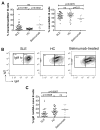Checkpoints for Autoreactive B Cells in the Peripheral Blood of Lupus Patients Assessed by Flow Cytometry
- PMID: 27059652
- PMCID: PMC5523861
- DOI: 10.1002/art.39710
Checkpoints for Autoreactive B Cells in the Peripheral Blood of Lupus Patients Assessed by Flow Cytometry
Abstract
Objective: Antinuclear antibodies (ANAs) are diagnostic in several autoimmune disorders, yet the failure to achieve B cell tolerance in these diseases is still poorly understood. Although secreted ANAs detected by an indirect immunofluorescence assay are the gold standard for autoreactivity, there has been no convenient assay with which to measure the frequency of circulating B cells that recognize nuclear antigens (ANA+ B cells) in patients. The aim of this study was to generate an assay to easily identify these B cells and to examine its utility in a study of autoreactive B cells in systemic lupus erythematosus (SLE).
Methods: We developed and validated a novel flow cytometry-based assay that identifies ANA+ B cells using biotinylated nuclear extracts, and utilized it to examine B cell tolerance checkpoints in peripheral blood mononuclear cells obtained from SLE patients and healthy controls.
Results: We observed progressive selection against ANA+ B cells as they matured from transitional to naive to CD27+IgD- and CD27+IgD+ memory cells in both healthy subjects and SLE patients; however, ANA+ naive B cells in SLE patients were not anergized to the same extent as in healthy individuals. We also showed that anergy induction is restored in SLE patients treated with belimumab, an inhibitor of BAFF.
Conclusion: This assay will enable studies of large populations to identify potential genetic or environmental factors affecting B cell tolerance checkpoints in healthy subjects and patients with autoimmune disease and permit monitoring of the B cell response to therapeutic interventions.
© 2016, American College of Rheumatology.
Figures



Similar articles
-
Loss of an IgG plasma cell checkpoint in patients with lupus.J Allergy Clin Immunol. 2019 Apr;143(4):1586-1597. doi: 10.1016/j.jaci.2018.10.041. Epub 2018 Nov 13. J Allergy Clin Immunol. 2019. PMID: 30439406 Free PMC article.
-
Phenotypic characterization of autoreactive B cells--checkpoints of B cell tolerance in patients with systemic lupus erythematosus.PLoS One. 2009 Jun 2;4(6):e5776. doi: 10.1371/journal.pone.0005776. PLoS One. 2009. PMID: 19488401 Free PMC article.
-
Aberrant Lower CD6 Expression on Peripheral B Cells Associated With Liver/Kidney Injury and Autoantibody Production of Systemic Lupus Erythematosus Patients.Scand J Immunol. 2025 Apr;101(4):e70018. doi: 10.1111/sji.70018. Scand J Immunol. 2025. PMID: 40134233
-
Correlation of circulating CD27high plasma cells and disease activity in systemic lupus erythematosus.Lupus. 2004;13(5):283-9. doi: 10.1191/0961203304lu1014oa. Lupus. 2004. PMID: 15230280 Review.
-
Aberrant B cell selection and activation in systemic lupus erythematosus.Int Rev Immunol. 2013 Aug;32(4):445-70. doi: 10.3109/08830185.2013.786712. Epub 2013 Jun 14. Int Rev Immunol. 2013. PMID: 23768157 Review.
Cited by
-
Silencing of high-affinity insulin-reactive B lymphocytes by anergy and impact of the NOD genetic background in mice.Diabetologia. 2018 Dec;61(12):2621-2632. doi: 10.1007/s00125-018-4730-z. Epub 2018 Sep 25. Diabetologia. 2018. PMID: 30255377 Free PMC article.
-
IgD+IgM- B Cells in Common Variable Immunodeficiency.Pathogens. 2024 Feb 1;13(2):136. doi: 10.3390/pathogens13020136. Pathogens. 2024. PMID: 38392874 Free PMC article.
-
B Cell Metabolism and Autophagy in Autoimmunity.Front Immunol. 2021 Jun 7;12:681105. doi: 10.3389/fimmu.2021.681105. eCollection 2021. Front Immunol. 2021. PMID: 34163480 Free PMC article. Review.
-
Different patterns of longitudinal changes in antinuclear antibodies titers in children with systemic lupus erythematosus and Sjögren's syndrome.Lupus. 2024 Dec;33(14):1594-1604. doi: 10.1177/09612033241298729. Epub 2024 Nov 4. Lupus. 2024. PMID: 39494571 Free PMC article.
-
Hyperactivation and altered selection of B cells in patients with paediatric Sjogren's syndrome.RMD Open. 2024 Mar 6;10(1):e003800. doi: 10.1136/rmdopen-2023-003800. RMD Open. 2024. PMID: 38453214 Free PMC article.
References
-
- Wardemann H, Yurasov S, Schaefer A, Young JW, Meffre E, Nussenzweig MC. Predominant autoantibody production by early human B cell precursors. Science. 2003;301:1374–7. - PubMed
-
- Yurasov S, Hammersen J, Tiller T, Tsuiji M, Wardemann H. B-cell tolerance checkpoints in healthy humans and patients with systemic lupus erythematosus. Ann N Y Acad Sci. 2005;1062:165–74. - PubMed
-
- Tiller T, Meffre E, Yurasov S, Tsuiji M, Nussenzweig MC, Wardemann H. Efficient generation of monoclonal antibodies from single human B cells by single cell RT-PCR and expression vector cloning [published erratum appears in J Immunol Methods 2008;334:142] J Immunol Methods. 2008;329:112–24. - PMC - PubMed
Publication types
MeSH terms
Grants and funding
LinkOut - more resources
Full Text Sources
Other Literature Sources
Medical
Research Materials

